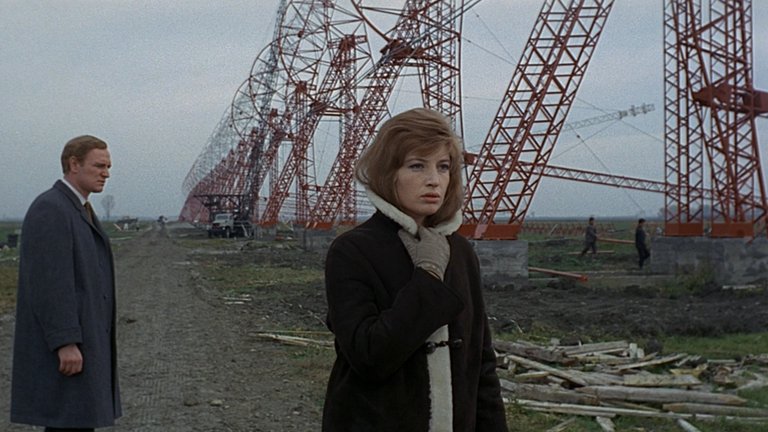Film Review: Red Desert (Il deserto rosso, 1964)

The 1960s marked a pivotal era in global cinema, characterised by significant transformations both in style and substance. This decade witnessed the gradual ascendancy of colour cinematography as the standard, particularly in commercial films, while black-and-white remained prevalent in serious dramas and arthouse productions. Among the directors who embraced this latter aesthetic was Michelangelo Antonioni, an Italian filmmaker renowned for his existential dramas. His earlier works—L’avventura, La Notte, and L’Eclisse—were all crafted in black-and-white, establishing him as a master of the form. However, in a notable shift towards modernity, Antonioni released his first colour film in 1964, aptly titled Red Desert, which continued his exploration of existential themes amidst the backdrop of a rapidly industrialising world.
Set in Ravenna, a port city in Northern Italy that has undergone swift industrialisation, Red Desert opens with the protagonist, Giuliana (played by Monica Vitti), approaching a massive petrochemical factory. She is accompanied by her young son Valerio (played by Valerio Bartolesci) on what appears to be a visit to her husband Ugo (played by Carlo Chionetti), who manages the facility. The narrative unfolds as Ugo greets Corrado Zeller (played by Richard Harris), a business associate seeking workers for an ambitious venture in Patagonia. During their interaction, Ugo reveals that Giuliana has recently recovered from a mental breakdown following a traffic accident. Although the accident left her physically unharmed, it deeply unsettled her psyche. Despite her evident instability, Corrado finds himself drawn to Giuliana, who, desperate to escape her mundane existence as a housewife and mother, engages in a brief affair with him. However, this liaison fails to provide her with lasting happiness; ultimately, she resigns herself to her bleak reality after contemplating a journey on a cargo ship.
Red Desert is often celebrated as one of the quintessential art films of the 1960s. Its prestige was solidified early on when it won the prestigious Golden Lion at the Venice Film Festival and garnered acclaim from critics and filmmakers alike, including notable figures such as Akira Kurosawa.
The film's visual composition is one of its most striking features, largely attributed to the exceptional colour cinematography by Carlo Di Palma. Antonioni's meticulous portrayal of the desolate industrial landscapes of Northern Italy serves not only as an aesthetic choice but also as a commentary on the dehumanising effects of modernity and industrialisation. Critics have frequently interpreted Red Desert as an early environmentalist statement against these forces. This perspective is notably supported by a dream sequence where Giuliana narrates a story to Valerio about a young girl (played by Emanuela Pala Carboni) enjoying blissful days on a pristine beach—a stark contrast to the oppressive grey tones of the urban environment that surrounds her.
Antonioni further amplifies this contrast by casting Monica Vitti—one of Italy's most enchanting actresses—as Giuliana, who embodies one of the least sympathetic characters in 1960s cinema. Her portrayal is complex; while she is visually captivating, her character's neuroses and emotional instability render her less relatable or likeable compared to her previous roles.
In an intriguing juxtaposition, Antonioni incorporates elements that could be perceived as "fan service," such as an impromptu gathering where Giuliana, Ugo, Corrado, and their friends engage in games with increasingly sexual undertones. The film even features an implicit sexual encounter; however, it is depicted in an unexpectedly un-erotic manner that aligns with the overall tone of disconnection prevalent throughout the narrative.
Despite its artistic merits, Red Desert faces criticism for its electronic music score composed by Vittorio Gelmetti. Rather than enhancing the film’s atmosphere, this soundtrack often detracts from its emotional depth and contributes to an impression of pretentiousness that some viewers may find off-putting.
Perhaps the most significant drawback of Red Desert lies in its deliberate pacing and lack of conventional plot structure. Audiences expecting a traditional narrative arc may find themselves disappointed; indeed, this slow tempo can alienate viewers unfamiliar with Antonioni's stylistic choices. This sentiment was echoed by French actress Mylene Demongeot, who reportedly fell asleep during its premiere despite being seated next to Antonioni himself.
While Red Desert can be appreciated for its technical prowess and quality performances—particularly from Vitti—its appeal remains limited primarily to aficionados of 1960s arthouse cinema. The film’s exploration of existential themes through its visual artistry presents a unique experience but ultimately requires patience and an appreciation for non-conventional storytelling.
RATING: 5/10 (++)
Blog in Croatian https://draxblog.com
Blog in English https://draxreview.wordpress.com/
InLeo blog https://inleo.io/@drax.leo
Hiveonboard: https://hiveonboard.com?ref=drax
InLeo: https://inleo.io/signup?referral=drax.leo
Rising Star game: https://www.risingstargame.com?referrer=drax
1Inch: https://1inch.exchange/#/r/0x83823d8CCB74F828148258BB4457642124b1328e
BTC donations: 1EWxiMiP6iiG9rger3NuUSd6HByaxQWafG
ETH donations: 0xB305F144323b99e6f8b1d66f5D7DE78B498C32A7
BCH donations: qpvxw0jax79lhmvlgcldkzpqanf03r9cjv8y6gtmk9
Posted Using InLeo Alpha
♦️ You got 0.01 FELT for sharing high vibes on Hive.
📋♦️ FELT Info